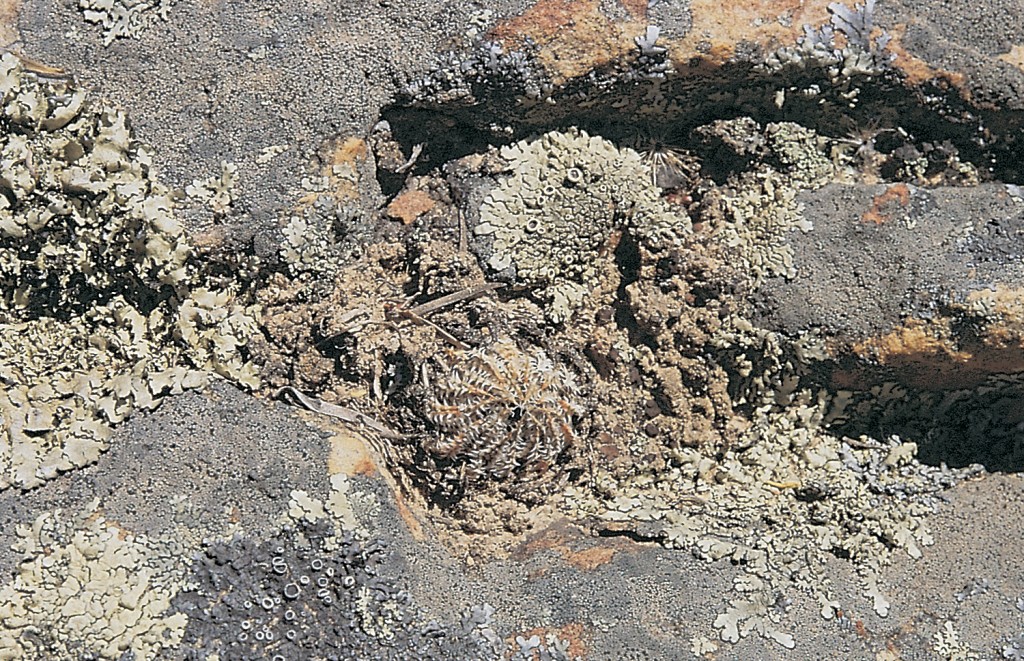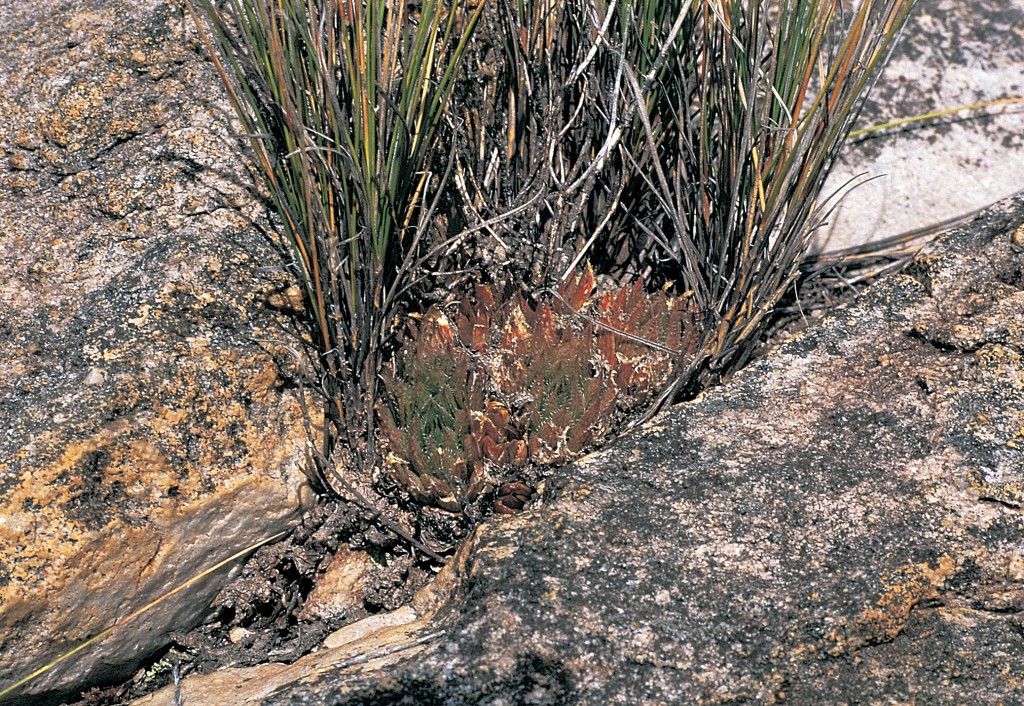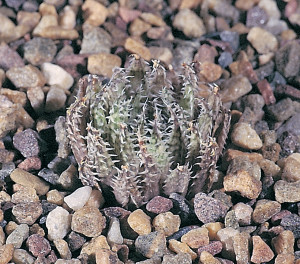15. Haworthia herbacea (Mill.) Stearn, Cactus J. 7:40(1938). Bayer, Nat.Cact.Succ.J 27:51(1972). Bayer :122(1976). Bayer :42(1982). Aloe herbacea Mill., Gardeners Dictionary :n18(1768). Type: icon, 130:t131 Boerhaave Index Alter Pl. (1720). Epitype (B&M): CAPE-3319(Worcester): N. Ribbokkop (-DC), Bayer 161 (NBG): A. atrovirens D.C., Pl.Gras. :f81(1799). H. atrovirens (D.C.) Haw., Revis. :57(1821). Type: as above: A. arachnoidea var. pumila Aiton, Hort.Kewensis 1:468(1789). Willd., Spec.Pl. 2:188(1799). A. pumila (Willd.) Haw., Trans.Linn.Soc. 7:10(1804). H. pumila (Willd.) Duval, Pl.Succ.Hort.Alenc. :7(1809). Haworth, Syn.Pl.Succ. :95(1811). Type: as above (Linnaeus, Aloe pumila var. E): Aloe translucens Haw., Trans.Linn.Soc. 7:10(1804). H. pellucens Haw., Syn.Pl.Succ. :96(1812). Aloe arachnoidea var. translucens (Haw.) Ker-G., Curtis’ Bot.Mag. t.1417(1811). H. translucens Haw., Suppl.Pl.Succ. :52(1819). H. arachnoidea (L.) Duv. sensu Scott, Cact.Succ.J(U.S.) 49:205(1977). Scott, Aloe 16:41(1978). Scott :39(1985). Type: Cape, Masson. Not preserved. Lectotype (designated here): icon. :t.1417 Curtis’ Bot. Mag.: H. pallida Haw., Revis.:56(1821). Type: Not preserved. Lectotype (designated here): icon (K): H. aegrota V.Poelln., Desert Pl.Life 11:193(1939). Type: Cape, Worcester, Swellendam etc. H. Venter. Not preserved. Lectotype (designated here): icon (B): H. submaculata idem. Type: Cape, Worcester, etc. H. Venter 5. Not preserved. Lectotype (designated here): icon (B): H. luteorosea Uitew., Cact.en Vetpl. 5:88(1939). Type: ex Hort, Holland. Not preserved.H. arachnoidea (L.) Duval sensu Scott, Cact. Succ. J. (US) 49:205 (1977).
herbacea: yellow-green.
Rosette stemless, proliferating, to 8cm φ. Leaves erect, incurved, scabrid, margins and keel with firm spines, greenish yellow in colour, reticulate patterning with translucent interstices. Inflorescence simple, to 300mm. Flowers large, beige, pinkish tips, buds bi-arcuate.
1982 – The choice of the name herbacea is possibly a poor one as this name is associated with a number of perhaps incompatible early illustrations. Scott’s selection of the name arachnoidea is equally dubious particularly as it also ignores the flower character. H. herbacea occurs only in the Worcester area extending in the southeast to east of McGregor, south into the mountains at Villiersdorp where a large flowered form occurs and to just northwest of Worcester itself. It is very close to H. reticulata and southwest of Robertson it is often difficult to know with which species one is dealing. However, H. herbacea usually has beige flowers, the plants are usually solitary, more deeply sunk in the ground, less proliferous and more hairy than H. reticulata. At De Wet the two species grow together and there are distinct hybrids. There are at least two other localities where both species grow in close association without hybridisation. H. herbacea flowers in late winter (September‑October) and has an unusually large flower. The Villiersdorp mountain form collected by E. Esterhuysen, has a particularly impressive flower but has not been introduced into cultivation. H. herbacea has a direct connection with H. maculata at the Brandvlei Dam south of Worcester. The size of the plant varies from 80mm in diameter to as little as 35mm near McGregor where the flowers may also be pinkish.
1999 – Nomenclature is indeed a slippery slope and this is a case in point. The name pumila which Duval applied in Haworthia, was based on Boerhaave’s early illustration as can be traced through a tortuous synonymy. It is in my opinion now invalid in the genus Haworthia, because the same type is used for the name herbacea. (see also Haworthia margaritifera). Apart from this nomenclatural tangle, the application of the name to a naturally occurring element is a problem. The Boerhaave illustration can perhaps be better related to Haworthia maraisii than to the species for which I have used the name. The earlier epithet atrovirens would have been a far better choice for that species had it been available. Rather than make this unfortunate change, and then also using the name translucens for this species, I am following a principle of conservation and letting sleeping dogs lie. It is enough that Col Scott has unfortunately confounded the issue by his use of the name H. arachnoidea for this species, without the acknowledgment in synonymy that may have clarified the issue.
The type nominated by Breuer and Metzing for H. translucens is based on the 1982 Handbook interpretation, where the name was applied incorrectly. It is apparent that H. translucens Haw. as perceived in 1819, includes the Botanical Magazine illustration cited above. This must be related to H. herbacea as understood here now.

a. var. herbacea.
The typical variety is widespread and relatively homogeneous throughout its range.
Distribution: 3319 (Worcester): Karoo Garden (-CB), Dobay 62 (NBG), Barker 8766 (NBG); Veld Reserve (-CB)., Olivier 129 (NBG, PRE), Pamphlet 44 (NBG); W. Worcester (-CB), Searle in NBG162/84 (NBG), Bayer 2421 (NBG); Brandwacht (-CB), Bayer in KG166/70 (NBG); SE. Brandvlei Dam (-CB), Bayer 2422 (NBG); W. Doornrivier (-CD), Bayer 1995 (NBG), Leipoldt (BOL); Lemoenpoort (-CD), Bayer 1996(NBG); N. Lemoenpoort (-CD), Bayer 4439 (NBG); Patryskloof, Mauve & Oliver 243 (NBG); De Wet (-DA), van Heerden 1024 (NBG); Rabiesberg (-DA), Esterhuysen & Lewis in NBG2689/35 (NBG); Ribbokkop (-DC), Bayer 161 (NBG); Keerweerder, Jonaskop (-DC), Bayer 2697 (NBG); Nuy (-DC), Hurling & Neil (BOL); Mowers (-DC), Bayer in KG218/70 (NBG); Wansbek (-DC), Bayer 1997 (NBG), Moffett in KG181/70; Rabiesdal (-DD), Heunis 1 (NBG); Koningsrivier (-DD), Bayer in KG 329/70 (NBG).
Inadequately located: Marloth 8912 (PRE); Worcester, Smith 3910 (NBG), Hurling & Neil (BOL), Venter 4 (BOL), Joubert 1 (BOL); Worcester to Robertson, Venter 5, 7 (BOL); ex hort, Leipoldt (BOL), Logan (BOL), Starke in BOL24591, Venter in NBG215/39, Aryer’s nursery (BOL); Ross-Frames in NBG78/44; Bonnievale, Malherbe in NBG297/40, van der Merwe 174 (BOL); Riversdale, Ferguson (BOL).

Haworthia herbacea var. herbacea JDV84/5 Ribbokkop. Grows, and hybridises with H. reticulata at this site. 
Haworthia herbacea var. herbacea JDV85/60 Bosfontein. The spination of the plants in this area is more pronounced. 
Haworthia herbacea var. herbacea JDV85/12 Sandberg. Here it is growing in quartzitic rock.
b. var. flaccida var.nov.
Type: CAPE-3319 (Worcester): Rooiberg (-DD), P.V.Bruyns 7114 (NBG, Holo.).
flaccidus: weak, soft.
Differs from the species in being small and delicate. There is considerable variation among the plants in habitat. (A var. herbacea foliis parvioribus et virellis differt).
The habitat of this variety is on steep north-facing rocks where the plants occur in small very dense clusters. They co-occur with H. maraisii and with H. reticulata. The former is on the same rock face but not as exposed, while the latter occurs on slopes both lower down and higher up on the mountainh. The locality is outside the known northeast distribution of the species. There are very few plants and the habitat is uncharacteristic of any of the species in the Southern Cape. The flower is outwardly identical to that of H. herbacea as is also that of H. pubescens. The flowering time co-incides with that of the latter but there is very little vegetative similarity.
Distribution: 3319 (Worcester): Rooiberg (-DD), P.V. Bruyns 7114 (NBG).

Haworthia herbacea var. flaccida JDV96/31 Rooiberg. Still very poorly known from only four clones. 
Haworthia herbacea var. flaccida JDV96/31 Rooiberg. This clone more closely resembles the typical variety.
c. var. lupula var.nov.
Type: CAPE-3319 (Worcester): Boscheveld Mt., Wolfkloof, Villiersdorp (-CD), E. Esterhuysen (NBG, Holo.).
lupula: small wolf as reference to origin.
Distinctive for the larger pink flower, and for the broader, shorter leaves which are more finely flecked and slightly less scabrid than the typical.
This variety was first collected by Elsie Esterhuysen who specialised in the flora of the Cape mountains. It occurs in sandstones, which is not unique for this species as it is also in sandstones south of McGregor. The occurrence is at the southwestern limits of the species. This is one of the elements which recurs through the Cape mountains and which suggest a common ancestry from here for at least the subgenus Haworthia. The similarities to H. vlokii, H. mirabilis var. consanguinea, H. maculata, H. variegata var. modesta (on the Potberg Mountain) and to H. turgida at high altitude are notable.
Distribution: 3319 (Worcester): Boscheveld Mt., Villiersdorp (-CD), E. Esterhuysen (NBG); Wolfkloof, Villiersdorp (-CD), Bayer 2579 (NBG).

Haworthia herbacea var. lupula JDV94/36 Villersdorp. A surprising occurrence in sandstone with Fynbos vegetation. 
Haworthia herbacea var. lupula JDV94/36 Villiersdorp. The flowers of this variety are surprisingly large and pinkish.
d. var. paynei (V.Poelln.) Bayer comb.nov.
H. paynei V.Poelln., Feddes Repert.Spec.Nov. 41:206(1937). H. pallida var. paynei V.Poelln., Cactus J 6:19(1937). Type: Cape, McGregor district, G. Payne. Not preserved. Neotype (designated here): CAPE-3319 (Worcester): Olifantsdoorn, McGregor (-DD), Bayer 4430 (NBG).
paynei: for G. Payne.
Mr George Payne accumulated an extraordinary collection of plants prior to the war and subsequently lost interest. This variety named after him is indeed different for its small size and for the bi-coloured flower which is pink above and white below. It is on the southeastern limits of the species and a still smaller proliferous form has been reported in the area.
Distribution: 3319 (Worcester): McGregor (-DD), Payne in PRE 27254, in PRE 34948, Bayer 695/69 (NBG); 1km S. McGregor (-DD), Bayer (NBG); Near McGregor (-DD), Smith 3978, 7196 (NBG); 3km E. McGregor (-DD), Scott 2203 (PRE); Olifantsdoorn, McGregor (-DD) Bayer 4430 (NBG).

Haworthia herbacea var. paynei JDV96/41 McGregor. A smaller plant and the flowers have pinkish upper lobes with traces of green, whereas the lower lobes are whiter
